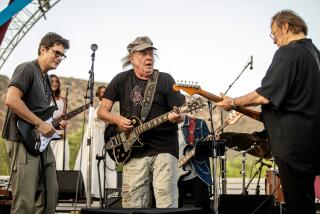Marl Young dies at 92; pianist was key in desegregating L.A. musicians unions
Marl Young, a musician who was instrumental in the merger of the all-black and all-white musicians unions in Los Angeles in the early 1950s and two decades later became the first black music director of a major network television series, “Here’s Lucy,” has died. He was 92.
Young, a recently retired longtime member of the board of directors of Professional Musicians Local 47, died Wednesday in a medical rehabilitation center in Los Angeles, said his granddaughter, Audrey Jackson. Young had prostate cancer, she said, but the exact cause of death has not been determined.
A pianist and arranger who arrived in Los Angeles from Chicago in 1947, Young became involved in the efforts of the black musicians union in L.A., Local 767, to unite with the white Local 47 in 1951.
“Segregation was a way of life,” Young, who joined the all-black local in Chicago in 1933 at age 16, recalled in a recent interview with Overture, the Local 47 newspaper. “It was just the way things were.”
But times were changing.
“There was a group of us that got together and said we wanted to end segregation in Local 47,” Young said. “The purpose of each union, as stated in the bylaws, was to unite all the professional musicians of the Los Angeles area.
“To unite the two organizations would be proper, because it would live up to that portion of the bylaws.”
Young was “one of the key figures in moving from segregated unions into an integrated American Federation of Musicians,” said Steven Isoardi, who interviewed Young for “Central Avenue Sounds: Jazz in Los Angeles,” a 1998 book published by the University of California Press.
Along with fellow black musician union members Buddy Collette and Bill Douglass, Isoardi said, Young “led the fight to eliminate segregation in the Los Angeles Local of the AF of M.
“Not only was Marl articulate and smart, but he had a law degree, and so he was the one who came up with a formula for how to do this, which was an amalgamation of segregated unions by merger. It’s a formula that was [later] followed nationally.”
At the same time black members of Local 767 were working to end segregation in Local 47, Isoardi said, a number of similar-minded white musicians were working toward the same goal. “It wasn’t just the black local,” he said.
But there also “were people within the black local and white local who didn’t want it,” he said. “It was a long battle.”
Young wrote the merger proposal that the two unions voted on, and on April 1, 1953, the two locals officially merged.
That, Isoardi noted, was one year before Brown vs. Board of Education, the landmark U.S. Supreme Court decision that outlawed segregation in public schools. And it was two years before the Montgomery bus boycott in Alabama.
“So these civil rights battles were being fought elsewhere earlier,” he said, “and these guys were doing it.”
“When we achieved our amalgamation, then it became evident to the AFM that segregation was on the way out,” Young said in his Overture interview. “That’s when they started their civil rights movement.”
In his interview with Isoardi, Young said the struggle to end segregated locals in Los Angeles “brought me out of my shell, I guess, because then I got on the board of directors of the NAACP, and I became a political power.”
In 1957, Young became the first black member of the Local 47 board of directors.
A year later, singer Marilyn Lovell asked him to accompany her on her audition for the Lucille Ball-Desilu Workshop Theater. That led to Young’s long association with Lucille Ball and Desi Arnaz.
In 1959, according to the Overture article, Young began doing the basic arrangements for the workshop theater.
And, in 1962, Arnaz asked him to be the pianist in the studio audience warmup band for Ball’s sitcom “The Lucy Show.” Young later did some composing and arranging for the show.
In 1970, after the death of Ball’s longtime music director Wilbur Hatch, Young took over as music director of Ball’s latest sitcom, “Here’s Lucy.” Young then integrated the show’s recording orchestra, hiring a black saxophonist, trombonist and trumpeter.
When Ball’s series ended in 1974, Young ran for -- and won -- the full-time position of Local 47 secretary; he served for eight years.
He completed his last term as a member of the board of directors in 2008.
Young was born in Bluefield, Va., on Jan. 29, 1917, and moved with his family to Chicago seven years later.
He began playing piano at age 6, and by the time he was in high school, he was spending his nights playing piano in speakeasies and “bawdy houses.”
Later, while writing arrangements and conducting nightclub floor shows, he attended John Marshall Law School in Chicago. He graduated in 1943 but was so involved with music that he never took the bar exam.
Young was married and divorced twice.
In addition to his granddaughter, he is survived by a son, Marl A. Young; and a great-grandson, Daniel Pickens.
A memorial service is pending.
More to Read
Start your day right
Sign up for Essential California for the L.A. Times biggest news, features and recommendations in your inbox six days a week.
You may occasionally receive promotional content from the Los Angeles Times.






